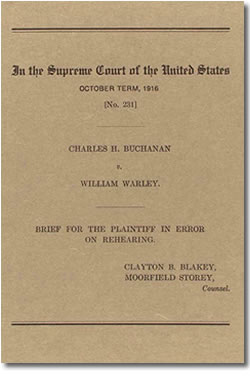1917: Buchanan v. Warley
The United States Supreme Court declares racially biased zoning unconstitutional.
- The Buchanan decision marked a victory in the battle against racial segregation; however it focused only on upholding property rights, not affirming equal protection under the law.
- Buchanan only applied to legal statues, not private agreements, and as a result, racially restrictive covenants became a common practice.
What is racially biased zoning?
Prior to World War I, Mid-Atlantic States along the border of the South began to adopt zoning ordinances that enforced residential segregation in response to the migration of blacks from the “Deep South” states. For example, Louisville, Kentucky forbade a “colored” person from moving into a home in a neighborhood with a majority of white residents and vice versa.
How was it challenged?
Buchanan v. Warley was brought forth by a white real estate agent after a black civil rights activist, William Warley, refused to pay full price for the property he had purchased. Warley claimed that the ordinance prohibiting blacks from moving into white neighborhoods made the lot less valuable because he could not actually occupy the property as a resident.
In its unanimous decision, the Supreme Court found that Louisville’s racial zoning ordinance violated the 14th Amendment’s due protection clause and marked an infringement of contractual freedom because it interfered with private property sales between whites and blacks. While the Buchanan decision marked a victory in the battle against racial segregation, it focused on upholding property rights, not affirming equal protection under the law. Buchanan only applied to legal statues, not private agreements and as a result, racially-restrictive covenants became a common practice (see restrictive covenants).


 Charles H. Buchanan v. William Warley Brief for the Plaintiff in Error on Rehearing
Charles H. Buchanan v. William Warley Brief for the Plaintiff in Error on Rehearing